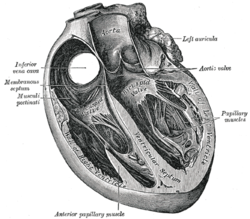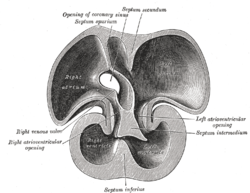- Interventricular septum
-
Interventricular septum 
Section of the heart showing the ventricular septum. 
Interior of dorsal half of heart of human embryo of about thirty-five days. (Labeled as 'septum inferius') Latin s. interventriculare cordis Gray's subject #138 535 Artery anterior interventricular branch of left coronary artery MeSH Heart+Septum Interventricular septum (or ventricular septum, or during development septum inferius), abbreviated IVS, is the stout wall separating the lower chambers (the ventricles) of the heart from one another.
The ventricular septum is directed obliquely backward and to the right, and is curved with the convexity toward the right ventricle: its margins correspond with the anterior and posterior longitudinal sulci.
Contents
Portions
- The greater portion of it is thick and muscular and constitutes the muscular ventricular septum.
- Its upper and posterior part, which separates the aortic vestibule from the lower part of the right atrium and upper part of the right ventricle, is thin and fibrous, and is termed the membranous ventricular septum (septum membranaceum).
Development
- The muscular part of the interventricular septum derives from the bulboventricular flange which is developed due to differential growth of primitive ventricle and bulbous cordis. Membranous part has a neural crest origin which connects the upper free margin of the bulboventricular flange and anterior and posterior endocardial cussions of atrio ventricular valve. it also gets attached to lower border of spiral septum or the aortico pulmonary septum.
Disorders
A hole in the interventricular septum is termed a ventricular septal defect (VSD).
Additional images
External links
- Interventricular+septum at eMedicine Dictionary
- Histology at OU 128_06 - "Heart and semilunar valve"
Categories:- Cardiac anatomy
Wikimedia Foundation. 2010.

